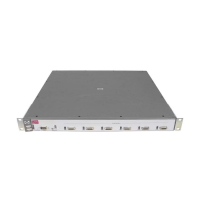IP Routing Features
Configuring Static IP Routes
■ Null (reject) – the static route consists of the destination network
address and network mask, and the reject parameter. Typically, the null
route is configured as a backup route for discarding traffic if the primary
route is unavailable.
Static IP Route Parameters
When you configure a static IP route, you must specify the following
parameters:
■ The IP address and network mask for the route’s destination network.
■ The route’s path, which can be one of the following:
• The IP address of a next-hop gateway
• A “null” interface. The routing switch drops traffic forwarded to the
null interface.
The routing switch also applies fixed (non-configurable) default values for
the following routing parameters:
■ The route’s metric – The value the routing switch uses when comparing
this route to other routes in the IP route table to the same destination. The
metric applies only to routes that the routing switch has already placed
in the IP route table. The fixed metric for static IP routes is 1.
■ The route’s administrative distance – The value that the routing switch
uses to compare this route with routes from other route sources to the
same destination before placing a route in the IP route table. This param-
eter does not apply to routes that are already in the IP route table. The
fixed administrative distance for static IP routes is 1.
The fixed metric and administrative distance values ensure that the routing
switch always prefers static IP routes over routes from other sources to the
same destination.
Static Route States Follow Port States
IP static routes remain in the IP route table only so long as the next-hop
gateway, port, or virtual interface used by the route is available. If the gateway
or port becomes unavailable, the software removes the static route from the
IP route table. If the gateway or port later becomes available again, the
software adds the route back to the route table.
This feature allows the routing switch to adjust to changes in network
topology. The routing switch does not continue trying to use routes on
unavailable paths but instead uses routes only when their paths are available.
11-18

